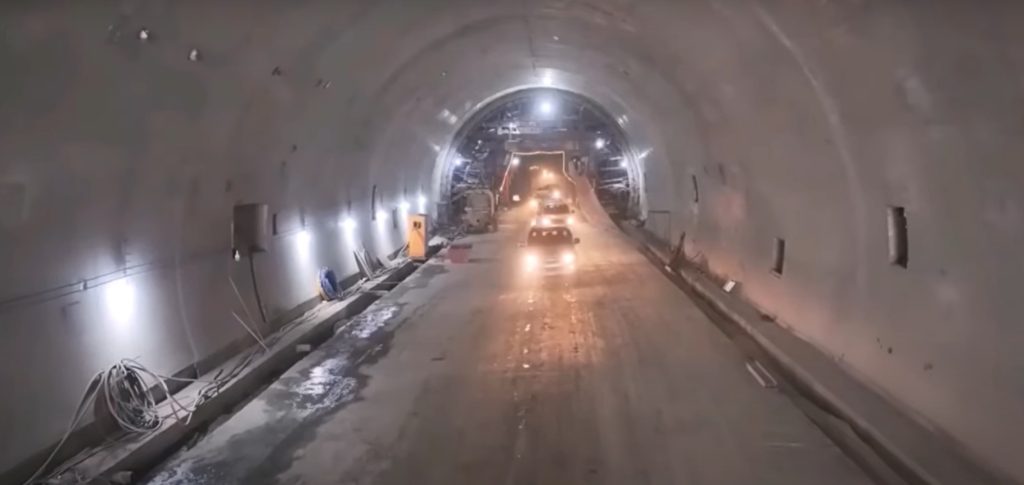
Under the Nepal Army’s leadership, the Kathmandu–Tarai–Madhes Fast Track, a project of national pride, has advanced 37% in just seven years.
The Nepali Army spokesperson, Brigadier General Gaurav Kumar KC, stated that as of mid-January of the current fiscal year 2024–2025, the project’s physical progress is 37.60 percent, while its financial progress, including project mobilization, is 39.56 percent.
Twelve of the thirteen construction packages—packages No. 1, 2, 3, 4, 5, 6, 7, 8(a), 8(b), 9(a), 9(b), and 10—are presently in the building and implementation phase, according the project’s overall work plan.
The Nepali Army claims that because of unresolved land acquisition concerns, the procurement process for Package No. 11, which covers the Khokana–Bungamati segment, has not yet started.
Seven tunnels totaling 10.979 kilometers are part of the fast track, and the building is moving quickly.
The Nepali Army claims that the Mahadevtar Tunnel in Package No. 1 is 3,355 meters long overall.
Among these, 2,228 meters (68%) of the right tunnel and 2,020 meters (61%) of the left tunnel have already been dug up.
With a total length of 1,691 meters, Package No. 2’s Dhedre Tunnel has made progress in both the left (1,728 meters) and right (1,653 meters) tunnels that lead from Nijgadh to Kathmandu.
The twin tunnels in Bakaiya’s Lendanda and Makwanpur’s Gadhi Rural Municipalities have advanced significantly under package 3.
In the Nepali month of Ashad, the 1,623-meter tunnel connecting Nijgadh and Kathmandu was finished, and in Jestha, the 1,633-meter tunnel connecting Kathmandu and Nijgadh was finished.
In accordance with procurement agreements, Package No. 4, which contains the 1,000-meter Deuichaur Tunnel, and Package No. 5, which includes the 390-meter Sisautar Tunnel, are presently in the design stage.
The 2,250-meter Chandram Bhir Tunnel in Package No. 6 is currently undergoing portal preparation work, and after procurement agreements, the 583-meter Mauri Bhir Tunnel in Package No. 7 is currently in the design stage.
Procurement agreements have been signed for the building of 85 of the 89 planned bridges. Five bridges in Bakaiya, Makwanpur’s Rajdamar neighborhood have been finished thus far.
At other sites, foundation work for a variety of bridge designs with heights up to 81 meters is currently in progress.
Purchasing Land
About 17,651 ropanis of land are needed for the project’s construction, according to the authorized Environmental Impact Assessment (EIA) and Supplementary Environmental Impact Assessment (SEIA). Of them, 5,487 ropani of land are privately owned.
4,818 ropanis of private land have already been purchased out of the 5,204 ropanis for which notifications have been issued thus far.
The cost of 203 ropanis in the Khokana-Bungamati segment of the remaining land that needs to be purchased has been decided, but payment has not yet been made.
Furthermore, 165 ropanis have not yet been valued, making 368 ropanis the total amount of land that remains.
In addition, there are still four ropanis in the Kathmandu district and sixteen in the Makwanpur district that need to be purchased.
According to the Nepal Army, 705,552 saplings have been planted as restitution for the 36,179 trees that were taken down.
According to the supplemental Environmental Impact Assessment (EIA), further land purchase and tree cutting outside the designated right-of-way have been authorized in accordance with construction-related changes and alterations as well as updated design alignments.
The Rajdamar, Bagdev, and Nijgadh parts (from 49 km to 70 km) and the Mahadevtar, Dhedre, and Lendanda sections (from 26 km to 35 km) received authorization for land acquisition and tree cutting on December 28, 2023, according to the supplemental Environmental Impact Assessment (EIA) report.
According to the Nepali Army, the tree-cutting is over, and the land transfer procedure is now under progress.
On April 19, 2024, the Ministry of Forests and Environment made a ministerial-level decision to approve the supplemental Environmental Impact Assessment (EIA) report for the Ranisera and Budune parts of the highway (from 35 km to 49 km).
The approval process for land usage rights and tree cutting is presently in progress. Sub-base preparation, bio-engineering, roadside buildings, wall construction, and service roads are among the construction projects that are moving quickly forward.
Similarly, on September 5, 2024, the Cabinet of the Nepal Government decided to approve the use of 51.871 hectares of national forest land in Makwanpurgadhi Rural Municipality-1, Hetauda Sub-metropolitan City-18, and Bakaiya Rural Municipality-5 in Makwanpur district under Subsection (10) of Section 42 of the Forest Act, 2076.
Additionally, 27,748 trees and poles of various types were felled as part of the approval. 4,225 trees have been felled thus far.
Khokana is the starting point of the 70.977-kilometer Kathmandu-Terai-Madhes Fast Track, which ends in Nijgadh, Bara.
The government, led by then-prime minister Pushpa Kamal Dahal “Prachanda,” first gave the project to the Nepali Army in 2017 with a four-year completion timeline.
After it became clear that the initial timeframe could not be completed, the project’s completion date was delayed from 2023 to 2024 to 2027.
Originally projected to require an expenditure of Rs. 175 billion to complete, the final cost has now increased to Rs. 211.93 billion.
Six Chinese businesses are working with Nepali construction companies on the project.
When the fast track is finished, it should save more than Rs. 50 billion a year in transportation expenses and cut the travel time from Terai to Kathmandu by four hours.











